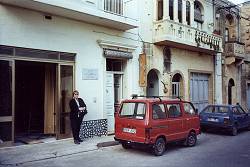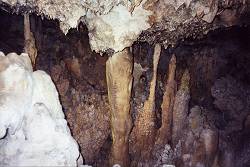Għar Ninu
Ninu’s Cave - Ta Ninu Cave
Useful Information

© Tony Oldham, 21-FEB-2002, with kind permission.
| Location: |
15 Triq Jannar, Ix-Xagħra, Gozo, Malta.
In the rear of No 15 January Street (15 Triq Jannar). (36.051276, 14.264603) |
| Open: |
All year Mon-Sat 15:30-18:30. [2024] |
| Fee: |
Adults EUR 4. [2024] |
| Classification: |
 Karst Cave Karst Cave
|
| Light: |
 Incandescent Incandescent
|
| Dimension: | |
| Guided tours: | self guided, D=15 m. |
| Photography: | Allowed |
| Accessibility: | Not accessible, many stairs |
| Bibliography: |
Trevor S. Shaw (1951):
The Caves of Gozo,
BSA Cave Science, (16) pp. 339-347. |
| Address: | Għar Ninu, 15 Triq Jannar, Xaghra, Gozo, Tel: +356-556863. |
| As far as we know this information was accurate when it was published (see years in brackets), but may have changed since then. Please check rates and details directly with the companies in question if you need more recent info. |
|
History
| 1888 | discovered by Joseph Rapa while digging a well under his house. |
Description
Għar Ninu is a small cave which consists actually of a single chamber. In 1888 the owner of the house, Joseph Rapa, started to dig a well under his house. This seems to be quite common in this are, which is rather strange, as the area is karstified limestone. It seems the karst water table is not that deep, otherwise it would be impossible to find water with a well. But he was surprised by not finding water, but a cave instead. It was very well decorated with stalactites, stalagmites, and even some helictites, so he made it accessible by building a spiral staircase into the well, and by installing electric light, After a descent of only 4 m the floor of the chamber is reached, there is a short trail, but actually the visit takes only 15 minutes, as the cave is very small. The diameter of the well is restricted, as a result the staircase is very narrow and not really suitable for obese visitors.
We have updated the listing in [2024] and were astonished by some strange comments on the web. The cave was once listed with a ridiculous entrance fee of € 1, now it is listed with a fee of € 4, but others say that there is actually no fee at all, the owner simply asks for a donation for a local charity. We would like to believe that this last option is the right one. However, the cave is still under the private house which is inhabited by the granddaughter of the discoverer. She opens the cave on weekdays in the late afternoon, not all days the full day as before, probably a result of the pandemic and the massive decrease of visitors. If the door is closed, just ring the doorbell.

© Tony Oldham, 21-FEB-2002, with kind permission.
This cave is located in the rear of No 15 January Street, about 75 m north west of the parish church, in the village of Xaghra, 3 km north east of Rabat on top of Ta Xaghra hill and well signposted. The granddaughter of the discoverer will answer questions and allow the visitor to take a self guided tour. The cave is illuminated by electric lights.
The cave, which is formed in the Upper Coralline Limestone, was originally discovered in 1888 whilst the householder was digging a well for water. It was immediately considered remarkable because of the prolific number of formations.
It is entered via a 4 m descent down a flight of steps, which end in a large chamber approximately 20 m by 8 m. However, because of the thick stalactite columns which stretch from floor to ceiling, it appears to be a passage with other passages going off. Even today the formations are still magnificent with numerous columns standing side by side like some petrified forest. In the past the cave must have been even more spectacular because there is evidence of numerous straw stalactites, which have now been broken off. There are even a few helictites. The formations are now dry and mainly the same colour as the surrounding rock, although some are semitransparent and it is possible to see the rings formed as they grew.
Text by Tony Oldham (2002). With kind permission.
 Search DuckDuckGo for "Għar Ninu"
Search DuckDuckGo for "Għar Ninu" Google Earth Placemark
Google Earth Placemark OpenStreetMap
OpenStreetMap Ninu’s Cave - Wikipedia (visited: 21-AUG-2024)
Ninu’s Cave - Wikipedia (visited: 21-AUG-2024) Visiting Ninu’s Cave In Gozo | Gail at Large (visited: 02-AUG-2015)
Visiting Ninu’s Cave In Gozo | Gail at Large (visited: 02-AUG-2015) Ninu’s Cave - Atlas Obscura (visited: 21-AUG-2024)
Ninu’s Cave - Atlas Obscura (visited: 21-AUG-2024) Index
Index Topics
Topics Hierarchical
Hierarchical Countries
Countries Maps
Maps